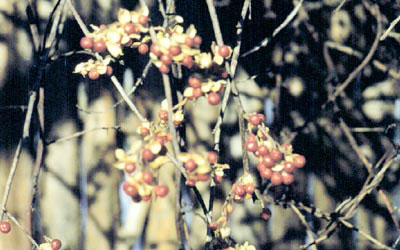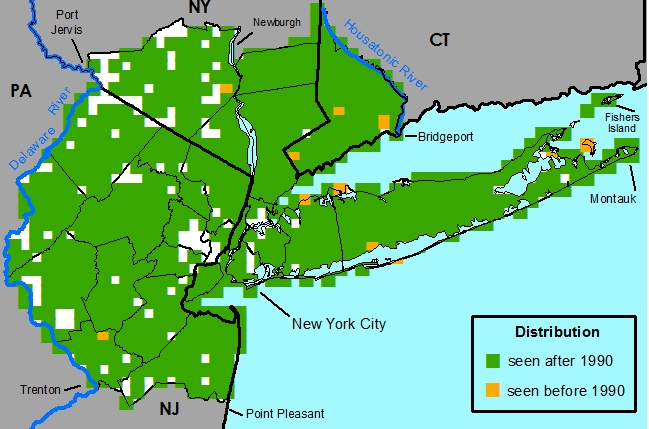Celastrus orbiculatus Thunb. - Oriental Bittersweet, Asiatic Bittersweet

Photo © by Thomas Delendick.
Taken at the Brooklyn Botanic Garden, 1970.

Common Names
Oriental Bittersweet, Asiatic BittersweetField Identification
A scandent shrub or more commonly a vine with bright yellow and orange fruit in the fall. Differs from the related American Bittersweet in having axillary inflorescences, usually broader and obovate leaves, and is much more common in the region today.Other uses
Often collected in the fall for the colorful berries and arils, which are used in dry flower arrangements.Poisonous Properties
Disclaimer The information provided here is for reference and historical use. If you believe you have been poisoned, please contact the Poison Control Office near you. (Look for the number in the front of the phone book.)
(Moerman, D. E., 1998), (Lampe & McCann, 1985)
The berries of the related C. scandens were considered poisonous by the Iroquois and Oglala. All parts of that species are reported to be poisonous, but there are no reports of the poisonous principal.
Nomenclature
Celastrus orbiculata Thunb., Fl. Jap. x1ii. 1784. Celastrus articulatus Thunb., Fl. Jap. 97. 1784. Celastrus articulatus var. orbiculatus (Thunb.) Wang., Chin. J. Bot. 1: 62. 1936. TYPE: Collector unknown (photo A).Celastrus tatarinowii Rupr., Bull. Acad. Imp. Sci. Saint-Pétersbourg 15: 357 (1857). TYPE: Unknown.
Celastrus articulatus var. pubescens Makino, Bot. Mag. (Tokyo) 7: 102. 1893. TYPE: Japan. Tosa: Ochi, Otsurutsu, Akinikawa, Makino, s.n. (Holotype: ?).
Celastrus articulatus var. cuneata Rehder & Wilson in Sarg., Pl. wilson. 2: 350. 1915. TYPE: Wilson 2308 (Holotype: A).
Celastrus lancifolia Nakai, Bot. Mag. (Tokyo) 37:3. 1923. TYPE: two elements.
Celastrus insularis Koidz., Bot. Mag. (Tokyo) 39:22. 1925. TYPE: Japan. Okinokuni, Prov. Fuse, July 1924, Koidzumi, s.n. (Holotype: ?).
Celastrus strigulosus Nakai, Bot. Mag. (Tokyo) 40:492. 1926. TYPE: Japan. Nikko Prov., Shimotsuke, Nakai, s.n. (Holotype: TI).
Celastrus articulatus var. stephanotiifolius Makino, J. Jap. Bot. 3:24. 1926. Celastrus stephanotiifolius Makino, J. Jap. Bot. 3:46. 1926. TYPE: Unknown.
Celastrus orbiculatus var. aurea-arillata Honda, Bot. Mag. (Tokyo) 45:422. 1931. TYPE: Japan. Hondo, Okuyama Prov., Totomi, 1930. D. Shimisu 50 (Holotype: ?).
Celastrus jeholensis Nakai, Rep. Exped. Manchoukuo, sect. IV, 1: 6. 1934. TYPE: Unknown.
Celastrus articulatus var. papillosus Nakai ex Hara, J. Jap. Bot. 10: 84. 1934. Celastrus orbiculatus var. papillosus (Nakai) Ohwi, Fl. Jap. 736. 1953. TYPE: Unknown.
Celastrus versicolor Nakai, Bull. Natl. Sci. Mus. 33: 16. 1953. TYPE: Unknown.
Celastrus orbiculatus var. pilosus Nakai, Bull. Natl. Sci. Mus. 33: 16. 1953. TYPE: Unknown.
Description
PLANTS perennial, deciduous, phanerophytic or liana, shrubs or woody vines, monoclinous.STEMS climbing, round. Prickles absent. Bark striate, not exfoliating, dark brown or brown. Branches horizontal. Twigs dark brown or brown or light gray, not odoriferous, round, 1.5-2 mm in diam., smooth, glabrous, without glands. Pith present, white, round, continuous, nodal diaphram absent. Thorns absent. Aerial roots absent. Sap translucent. Resin absent.
BUDS axillary only, scattered along stem, 1 per axil, broadly ovoid, 0.8 mm long, pointed. Bud scales 4, orange, imbricate, broadly ovoid, membranaceous, acute, papillose, without glands. Bud scale scars not encircling the stem. Leaf scars nearly circular, 1.1-1.2 mm high, 1.1-1.2 mm wide. Vascular bundle scars 1, crescent-shaped, 0.2-0.3 mm tall.
LEAVES alternate, spiral, 1 per node, spaced somewhat evenly along stem, divergent from stem, simple. Stipules present, lateral, deciduous, free from the petiole, filamentous, margins pectinate. Leaves petiolate, petiole terete, 0.8-3 cm long, glabrous, without glands. Leaf blades greenish-yellow, widely elliptic or widely ovate to widely obovate or circular, plane, bilaterally symmetric, (2-)3.5-10.7 cm long, (1.5-)2.9-7.6 cm wide, membranaceous, base cuneate or obtuse, margin crenate-serrate, apex acute or cuspidate, abaxial surface glabrous or with short, unbranched, erect, unicellular, white, sparse hairs distributed along midveins, without glands. Adaxial surface glabrous, without glands. Veination eucamptodromous, veins 3-6 pairs. Spines absent. Tendrils absent.
INFLORESCENCES bisexual, simple, raceme, axillary. Peduncle present, 0.5-0.7 cm long. Rachis present, 0.1 cm long. Bracts sessile, dark greenish-yellow, narrowly triangular, involute, 0.6 mm long, 0.1 mm wide, base truncate, margin erose, apex acute, abaxial surface glabrous, without glands, adaxial surface glabrous, without glands. Pedicel 1.5-3 mm long, without glands. Bracteoles not seen.
FLOWERS serotinous, formed on the current season's growth, bisexual or unisexual, with sepals and petals readily distinguishable from one another, 5-merous, 1.8-4 mm long, 2.2-5.5 mm wide, 3-4 flowers per inflorescence, perianth of 2 whorls. Calyx present, actinomorphic, campanulate, of fused sepals, deciduous, greenish-yellow, 1-2.1 mm long, 2.1-2.3 mm wide, tube 0.7 mm long, 1.4-2.8 mm wide, calyx limb 5-10 mm long, 1.5-2.5 mm wide. Sepals or sepal lobes 5, widely depressed-ovate, 0.5-1.5 mm long, 0.7-1.2 mm wide, base truncate, margin erose or ciliate, apex obtuse, abaxial surface glabrous, without glands. Epicalyx absent. Corolla present, actinomorphic, campanulate, of free petals, deciduous, yellowish-green. Petals or petal lobes 5, elliptic, 2.6-5 mm long, 0.9-2 mm wide, base truncate, margin entire, apex obtuse, glabrous, without glands. Gynoecium syncarpous. Carpels 3. Locules 3. Stigmas 1, capitate. Styles 1, not persistent, 2.3-3 mm long. Ovary superior, glabrous, glands absent, nectiferous disk present. Placentation basal. Androecium alternate, exserted, haplostemous, introrse. Stamens 5, 1.3-2.8 mm long. (Smaller stamens are in male-sterile flowers.) Anthers ovoid, opening along the long axis, opening entire length of anther, bithecal/tetrasporangiate, light red, glabrous, absent. Filaments straight, white, glabrous. Staminodes absent.
FRUITS light greenish-yellow to greenish-yellow, globose capsules, 6-9 mm long, 7-10 mm wide, glabrous, without glands.
SEEDS 3-6, light orange, oblong, 2.5-2.6 mm long, 1.5-1.6 mm wide, glabrous, without glands, wingless, not tailed, smooth, with a bright red aril surrounding the seed
Habitat
(Patterson, 1973), (Nash, 1919), (Robertson et al., 1994)Mixed oak forests, roadsides, forest margins, and sandy beachs. Most abundant in stands representing early stages of succession. Very shade tolerant, able to acclimate to low light levels under heavy shading and grow explosively if shading is reduced. Very abundant invasive plant, causing mechanical as well as shading problems. First introduced into the U.S. in 1860; first planted at N.Y.B.G. in 1897, from which the N.Y. Metro material is thought to have originated.
Distribution
United States: CT, DC, DE, GA, IA, IL, IN, KY, MA, MD, ME, MI, NH, NJ, NY, OH, PA, RI, TN, VA, VT, WV
NYMF NON-NATIVE: Throughout the region.
Species Biology
Prechilling Required -- Seed stratified for 90 days at 5º C, then planted in soil maintained at 20-25º, yielded 71% viability.